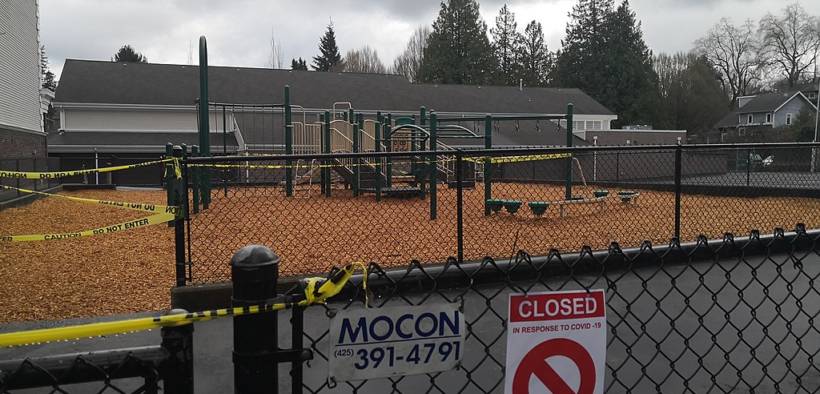Distance Learning Fails Students and Teachers during School Shutdown

One of the first steps taken by governments worldwide to stop the spread of COVID-19 was the closure of schools, colleges and universities. This obviously has had a major impact on students and teachers due to the drastic changes this has necessitated.
Parents are also struggling as many of them attempt to work from home while also making sure that their children are keeping up with their schoolwork. Obviously, the majority of parents are not educational professionals and do not know the best ways for a child to learn remotely. Teachers who are being forced to do their job from home while also doing many of the things that their children’s’ regular teacher would normally take care of are having an especially hard time.
Nonetheless, most teachers and educators think that the closure of schools was necessary, and appreciate the measures being taken to stop the spread of Coronavirus.
In Spain, Carmen Rianxo, a high school math teacher, said “I agree with the measures being taken because for me the most important thing the government can do right now is to protect people’s health and ensure that the healthcare system is not overwhelmed to the point that hospital personnel have to decide who to save.”
Teachers in the United States agree. Katie Benton, a fourth grade teacher in Columbus, Ohio, told Citizen Truth “I agree that schools needed to be closed in this time of global crisis. However, it did happen quickly and without much notice. That has been tricky, but I am not sure there was any other way to handle it. In Ohio, the governor acted swiftly and took the matter seriously, and I am proud of that response.”
Ohio’s quick response has proven to be beneficial in terms of stopping the spread of COVID-19 in the state, but will it have negative consequences for the state’s students?
The New Normal Reveals Inherent Problems with Education Technology
Since students are not able to be physically present in their actual classrooms, most instruction and work is taking place through distance learning, typically in the form of online platforms. However, this is a far from perfect solution.
Distance learning and other EdTech “innovations” are no strangers to criticism. Common complaints about these educational methods are lack of face to face interaction, heavier reliance on coursework instead of instruction and lack of structure. As all education goes online during the shutdown, these serious problems are becoming glaringly apparent.
John Gallagher, who teaches high school economics in the autonomous community of Galicia in northern Spain, told Citizen Truth that, “In order to avoid potential problems, teachers and schools are working to ensure that students don’t fall behind using online learning and other technologies. Nonetheless, many students don’t have all the necessary equipment or access to good internet connections.” Rianxo also worries about certain students’ ability to adequately access all of the technologies being employed during this period of distance learning.
Student Perspectives
Teachers aren’t the only ones who are unhappy with the way that learning is being conducted while schools’ doors are locked shut. Uxía attends the Universidad de Santiago de Compostela in Spain and told Citizen Truth “I personally have had a lot of problems. The web platforms often get overloaded and crash during timed online exams and tests, which has actually had a negative impact on our grades. The professors don’t know how to explain the assignments that they send themselves and change the evaluation criteria every day. Professors need to realize that not all students have their own computer or good internet connection, which shouldn’t cause someone’s grades to suffer. They should try and find ways to evaluate our capacity to learn and understand, not our ability to memorize PowerPoints.”
In Florida, Emma, a high school junior, complained about a general lack of instruction on the part of her teachers. “They’re just giving us assignments and expecting us to learn the material ourselves. I can’t just teach myself. You have to explain the material first, especially with something like math or something that’s so specific and needs to be done a certain way.”
Uxía agreed that professors and teachers need to work harder to ensure that the online learning taking place is an adequate substitute for classroom instruction. “Despite all the technology available to us, most of my professors are just sending us PowerPoint presentations and things to read without explaining anything. This isn’t teaching nor learning. Now we’re being almost entirely evaluated on extra exams and assignments that don’t really teach us anything and require a lot of time. I think that professors should try and interact more with their students and explore the available technological options instead of just sending presentations.”
Emma added, “I don’t think they have the right to test you on something they haven’t even taught you.” She also pointed out the inherent problems with online tests as an evaluative measure, telling Citizen Truth, “first of all, these online tests aren’t even fair because everyone’s just going to cheat.”
Online evaluations in her school district are conducted with computer cameras on, but she said, “in my opinion this is an invasion of privacy.”
Lack of Structure
Another concern related to digitized learning is the lack of a specific schedule or timetable. Rianxo explained that “Since students don’t have to be in the online classrooms at specific hours of the day, they have begun to waste their time.”
Gallagher added, “the effect that this will have on the students will depend on each person individually. Some teenagers function fine without routines and are capable of establishing their own rhythm of productivity so that they can be more or less self-sufficient, but without a doubt there are others who will struggle with the lack of structure and fall behind.”
The effect that this loss of classroom time could have in students could last well into the future, especially given that no one knows how long this situation will last for. Rianxo pointed out that “It’s important to consider that the negative consequences for the students could last into the next academic year. Second year Bachillerato students [last year of high school] will have to change some of their plans as a result of this because the calendar of university entrance exams has changed.”
Rianxo also worries that students are being overloaded with work as a result of having numerous homework assignments from classes like art and music that would normally be completed during the school day. “I think that the students are overloaded with work because all of the professors gave them assignments at once. All at once they have a huge course load in subjects like art and music that they wouldn’t normally in addition to the work they had to do in classes like math, science and English.”
Stay Positive
Benton is keen to emphasize that as important as it is that students don’t fall behind and are still doing schoolwork during the shutdown, the most crucial thing is that everyone protects their physical and mental well-being during this crisis. “I think that social and emotional well-being is the most important thing right now. Kids are not going to remember what they “learned” in terms of content during this time; however, they will remember what it felt like, the emotions and how things were going at home with their families. They will make up the areas they miss or where they regress during this time. They are also building character — learning life skills like being flexible, persevering, taking care of some of their personal needs each day and helping at home.”
In addition to what she would normally be teaching her students, Benton is taking advantage of the opportunity to enrich her lessons with useful information and activities that would not normally be taught by a schoolteacher. “I am teaching content but every day I am also doing a “Try This” with my students … teaching them to fold clothes, use email, make French Toast, play Jacks, building card houses and more. I feel like I am helping them learn things they need to know and also sharing ideas to keep them occupied and to learn new things/games/activities.”
Most teachers agree that parents and other educators should stay focused on the important things: their students and their families. Benton adds that it’s important to explain to young children why this is happening and what we can learn from it. She also recommends “staying positive at home, enjoying family time that you may never get again, and knowing that this too shall pass.”
It is crucial that parents, students and teachers stay flexible and focused during this period while realizing that things are going to be different. Rianxo told Citizen Truth, “I don’t see any way to mitigate the negative consequences for the time being. I think that if we are well-organized and establish reasonable schedules and timetables new technologies can help us at least have a tolerable situation. We also need to modify the course load and redesign the curriculum in a way that is reasonable and fair when it comes time to evaluate students’ work. We have to figure these things out in advance because it won’t be possible to just improvise.”
She adds “It appears that major alterations to the academic calendar are inevitable, and if it were up to me, I would shorten summer vacation by a month in order to make up for the class time lost during the quarantine.”
Emma certainly will not be happy if that happens in her school district and told Citizen Truth “If I had to go to school over the summer because of this I’d be livid. I haven’t failed any classes, so I shouldn’t have to go to summer school.”
Working Together
Many teachers are also growing frustrated with a lack of effort on the part of their students, but also lack of understanding from parents. Rianxo explained that “Parents are finding it difficult to control and supervise their children and also to help them with their assignments due to their own lack of knowledge. The impact on the parents is probably worse than on the students, and I assume that many parents are getting very overwhelmed.”
Parents are finding themselves in an unfamiliar and perhaps unwelcome situation, and many are unsure of the best way to help their children learn during this difficult time period. Benton mused, “Parents are dealing with something that has never happened and it’s scary. They didn’t sign up to home school and I don’t want them to have to do it. We continue to teach, but we also know that many kids don’t have support at home because parents are needing to work!”
However, despite all attempts being made to ensure that things run smoothly, everyone is starting to get a little frustrated. Rianxo continued, “something that really irritates me is that both students and parents are constantly complaining without thinking about the fact that most teachers are working a lot more than the normally would while having to modify their courses to fit the situation.”
When Will It End?
Gallagher is unsure how much and for how long the Coronavirus pandemic will affect his students’ education, explaining that “Only time will tell what the final consequences of this will be, especially seeing as we don’t know how long this is going to last.” This uncertainty seems to hang in every corner of the world right now, and the threat of future situations like this will certainly remain long after the shutdowns around the world have ended and schools and businesses reopen their doors.
Benton is trying to stay positive and recognizes the “resilience” of her students.
Rianxo worries that events like these will become more and more common in the future, leading to problems in education and other areas. “I am afraid that this situation will become a reality that repeats every year. We can’t let something like this that upends all economic, educational and cultural activities happen over and over. I don’t know what exactly, but something is going to have to put in place to make sure that this doesn’t happen again.”
Regardless of how long shutdowns and closures around the world continue, students will continue learning and teachers will continue teaching with varying degrees of success. However, given that these situations are likely to become more common in the coming future, educators, students and parents must work together to find novel solutions in this time of the novel Coronavirus.




















I think a separate meme section can be created already for distance teaching. I’ve already seen so much funny videos about it in COVID-19 chat in Utopia p2p. That’s really strange that we live in a social media era, but so many people still don’t used to it.